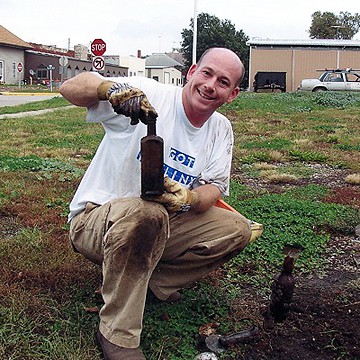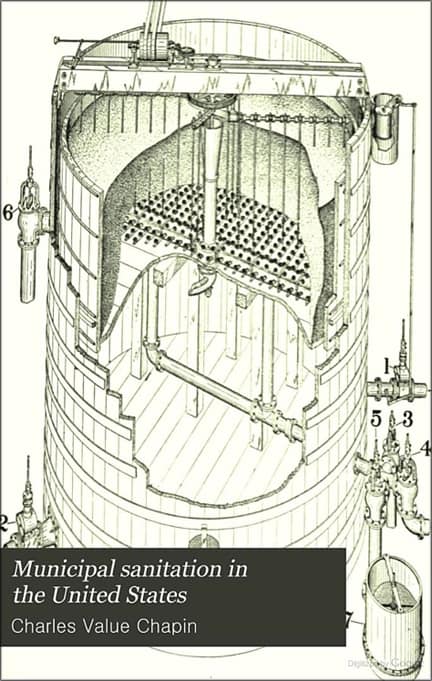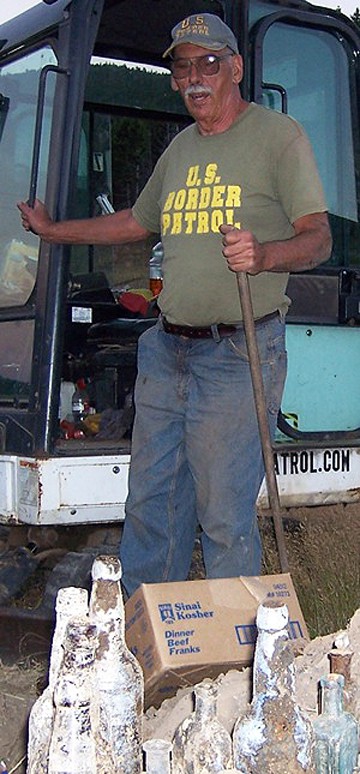Ferdinand,
I have put together a list of privy ordinances from Philadelphia, Cincinnati, and more than 2 dozen other cities.Some of these ordinances will show why it is tough to find bottles in some cities privies, especially when they mandated the cleaning and filling with ashes.Other ordinances mandated that privies be back from the street a minimum of 40 feet. All of the Utah ordinance I found were almost exactly the same on this requirement. Perhaps the most striking ordinance was in Savannah, Georgia. From 1831 until 1871 it was MANDATED that all privies be ATTACHED TO THE HOUSE! Hope you find this informative, Thanks –
Reg Shoeman
Ordinances Regulating Location, Depth, etc. of Urban Privies
Compiled by Reg Shoeman
Within the past few years Google Books has scanned many books in the public domain. I have searched the city council proceedings, boards of health, and other reports to cobble together this, a limited in scope, but very revealing bunch of ordinances.
Bottle diggers are often frustrated, when, after going down 15 feet they find nothing but ashes. This digest of ordinances will show the diggers of Indianapolis, Cincinnati, and Philadelphia and other cities that had similar ordinances why, at times, there was absolutely NOTHING in that 15 footer!
Some ordinances dictated privies be at least 30 feet from the building, Savannah mandated privies be ATTACHED to the houses for a 40 years span, from 1831 until 1871! Permits were required to clean privies and transport the contents.
The primary resource located was, “Municipal Sanitation in the United States” 970 pages, published in 1900, authored by Charles Value Chapin. Dates are provided for most ordinances, a handful are undated.
Depth Regulations
Brooklyn, New York, 1850 – No sink, privy, or cesspool in the first seven wards of the city unless made of brick or stone and 10 feet deep.
Chicago, Illinois, 1873 – They must be six feet deep if within forty feet of a street, dwelling house or well, but in such cases they must be water tight.
Cincinnati, Ohio, 1884 – Privies must be ten feet deep, lined with brick or stone, and watertight.
Jersey City, New Jersey, no date – Vaults must not be less than eight feet deep.
Louisville, Kentucky, 1851 – No privy shall be built without a vault at least twelve, nor’more than thirty feet deep, and walled with hard brick, nor shall any part of the contents of any privy vault be removed except by its being taken out of the city, or into the current of the river, in the night time.
Memphis, Tennessee, 1857, 1873 – It shall be a misdemeanor to construct a vault or privy less than fifteen feet deep.
Muscatine, Iowa, 1878 – Privy vaults shall be not less than four feet in depth, and shall be securely and substantially walled; and if the depth of such vault be six feet or more, it shall be walled with brick or stone.
Nashville, Tennessee, 1875 – Vault mandatory 1 ½ feet wide x 3 feet long, 3 feet deep MINIMUM, made of brick or rock and cemented, hook to sewer when available.
New Orleans, Louisiana, 1877 – None deeper than 2 feet
Ottawa, Illinois, 1883 – No person or persons shall construct on his or her premises any privy or privy vault within less than twenty feet of any dwelling, store, or business, unless the vault be at least five feet deep from the surface of the ground, and walled from bottom to top with stones, bricks, or wood
Patterson, New Jersey, no date – They must not be more than four feet deep.
Pennsylvania, no dates – Cities of the second class, (all cities except Philadelphia) vaults must be at least 6 feet deep.
Peoria, Illinois, 1869 – TENEMENTS…privy, the vault of which shall be sunk under ground at least ten feet deep, and shall be walled up with brick or stone, …
Phoenixville, Pennsylvania, 1856 – No Privy already set up in the Borough can be within 20 feet of any dwelling house, and dig a pit not less than 9 feet deep and securely wall up the same with stone or brick.
Pittsburgh, Pennsylvania, 1852 – …privy, shall call on the proper street commissioner and obtain, in writing, from him the depth which the same shall be sunk, and which in no instance shall be less than twelve feet; every privy shall be placed at least two feet from the line of the adjoining lot.
Quincy, Illinois, 1875 – No privy or privy vault within less than one hundred feet of any dwelling, store, office or place of work or business, unless the vault be at least ten feet deep from the surface of the ground, and walled from bottom to the top with stone or brick.
Reading, Pennsylvania, no date – Vaults must be twenty feet deep except as otherwise provided.
Richmond, Virginia, 1869 – No sink or cesspool shall be sunk unless the same be at least ten feet deep, and be lined at the sides and on the bottom with brick or stone; and the owner or occupant of premises to which any sink or cesspool belongs shall not permit the contents thereof to rise within two feet of the surface of the earth.
Rockford, Illinois, 1874 – Each and every house or tenement within said city, used as a residence, hotel, tavern or place of business, shall be furnished with a suitable privy, the vault of which shall be sunk under ground at least six feet deep, and walled up with stone, brick or plank.
Sacramento, California, 1874 – Each and every house or tenement within said city, used as a residence, hotel, tavern or place of business, shall be furnished with a suitable privy, the vault of which shall be sunk under ground at least six feet deep, and walled up with stone, brick or plank.
Saint Joseph, Missouri, 1869, 1897 – No person shall erect or continue any privy within twenty feet from any street, or the dwelling, shop or well of other persons, in said city, unless the same be furnished with a substantial vault at least six feet deep, and so the contents cannot escape, Penalty for violation…ten dollars.
Savannah, Georgia, 1871 – That the ordinance of September 22, 1831, requiring every dwelling in said city to have an excavated privy attached thereto, and all ordinances prescribing the manner in which said privies shall be constructed, are hereby repealed…..shall be supplied with a water closet, an earth closet or a movable and water tight surface drawer
Either the Georgia diggers knew of this ordinance years ago, OR, if you hear someone digging outside of your Savannah bedroom, you will immediately know what’s going on after this entry!
Saint Louis, Missouri, 1843, 1852, 1870, 1881 – Must be ten feet deep.
Sedalia, Missouri, 1894 – All privies shall be not less than four feet deep below the surface of the ground and securely walled or lined up with brick, stone or other substantial material, at least eight inches above the surface of the ground;
Wheeling, West Virginia, 1891 – Privy vaults or cesspools shall he not less than ten (10) feet deep, and shall he built with walls of brick or stone;
Wilmington, Delaware – Vaults must be twenty feet deep except as otherwise provided:
Location Requirements
Augusta, Georgia, 1900 – No surface privy shall exist within thirty feet of any dwelling house.
Davenport Iowa – Privy vaults shall not be located within two (2) feet of party lines or within twenty (20) feet from any building.
Fall River, Massachusetts – No privy shall open directly from any living or food storage room.
Ottawa, Illinois, 1883 – No person or persons shall construct on his or her premises any privy or privy vault within less than twenty feet of any dwelling, store, or business, unless the vault be at least five feet deep from the surface of the ground, and walled from bottom to top with stones, bricks, or wood.
Patterson, New Jersey, 1883 – No person or persons shall construct on his or her premises any privy or privy vault within less than twenty feet of any dwelling, store, or business, unless the vault be at least five feet deep from the surface of the ground, and walled from bottom to top with stones, bricks, or wood
Quincy, Illinois, 1875 – No privy or privy vault within less than one hundred feet of any dwelling, store, office or place of work or business, unless the vault be at least ten feet deep from the surface of the ground, and walled from bottom to the top with stone or brick.
Saint Joseph, Missouri, 1869, 1897 – No person shall erect or continue any privy within twenty feet from any street, or the dwelling, shop or well of other persons, in said city, unless the same be furnished with a substantial vault at least six feet deep, and so the contents cannot escape,Penalty for violation…ten dollars
Salt Lake City, Utah, 1860 – Any privy or pig-stye erected nearer than forty feet of the line of the streets of this city, is hereby declared to be a nuisance, and liable to be removed. (Several Utah cities with the same ordinance.)
Utica, New York – A vault must not be near enough to a house “to be detrimental.”
Privy Cleaning, Scavenger Licensing, and Transportation Requirements
Atlanta, Georgia, 1899 – Sanitary inspectors are required during the spring and summer months to inspect each privy weekly…
Augusta, Georgia, 1900 – Privies must be disinfected every two weeks.
Cincinnati, Ohio, 1884 – Whenever the use of any privy-vault is discontinued, such vault must be cleaned to the bottom and filled up with earth or other suitable material, such filling to be done under the supervision of a sanitary officer.
Indianapolis, Indiana, 1884 – Whenever the use of any privy-vault is discontinued, such vault must be cleaned to the bottom and filled up with earth or other suitable material, such filling to be done under the supervision of a sanitary officer.
Leadville, Colorado, 1881 – City Council or Mayor has the.power to direct the city scavenger, or others, at all times between the rising and setting of the sun, to enter any store, house, stable, or any building, and to cause the floors to be lifted up to examine cellars, vaults, sinks, and drains.
Philadelphia, Pennsylvania, 1876 – Every person, persons, or company licensed to clean privywells, sinks, etc., shall have a pit for depositing the contents of said wells, sinks, etc., (the location to be approved by the Board) and said pit shall not be located within two hundred yards of any public road, lane, or street, and shall be screened from public view.
Philadelphia, Pennsylvania, 1876 – Privy-wells ordered to be cleaned by the Board must be emptied to the bottom; the failure of the cleaners to obey this rule being of itself sufficient to suspend their licenses.
Philadelphia, Pennsylvania, 1856 – No tavern license be granted or removed, in any part of the city, unless the lot has sufficient space outside of the house for a privy.
Philadelphia, Pennsylvania – PERMITS FOR CLEANING PRIVIES ISSUED DURING THE YEAR 1860
January…….. 384
February…… 367
March……….. 699
April ………….637
May……………868
June …………..102
July ……………109
August ……….110
September….. 91
October…….. 343
November…. 271
December…. 167
Total 4,148
We find by this account that 4,148 permits for cleaning privies were granted during the year including those emptied by the Board on complaint allowing that under each permit four loads of filth were removed a moderate estimate each load containing 20 cwt it will be seen that 580,720 cubic feet equal to the extraordinary amount of 16,592 tons of human ordure have been removed
Pittsburgh, Pennsylvania, 1852 – …..privy, shall call on the proper street commissioner and obtain, in writing, from him the depth which the same shall be sunk, and which in no instance shall be less than twelve feet; every privy shall be placed at least two feet from the line of the adjoining lot.
Rochester, New York, 1875 – All owners and keepers of hotels, taverns, boarding houses, factories arcades, warehouses and establishments where more than ten persons are habitually gathered or employed, within the said city, shall cause to be constructed on their respective premises, one or more strong wooden boxes, slides or drawers, of suitable dimensions, provided with a convenient handle at each end, and with moveable lids, which may be fitted thereto perfectly tight; and shall cause such boxes to be placed under the seats of their respective privies,
San Francisco, California, 1872 – Permits for emptying privy vaults and cesspools for the year was two thousand and twenty-three (2,023).
Wheeling, West Virginia, 1891 – Privy vaults and cesspools that may be abandoned will not be allowed to be arched over, but cleaned out to the bottom and filled with earth.
Worcester, Massachusetts, 1854 – Any person may convey the contents of a Privy or Vault over the roads, highways and streets of the City, in the months of December, January, February and March, at any time, when the Mercury in the Thermometer is below twenty-five degrees of Fahrenheit’s scale; provided….
Additional sources, all Google ebooks
Savannah, Georgia, 1879 – Rebarer’s Digest: supplement to city code, 1871….ordinances
Salt Lake City, Utah, 1860 – Charter of Great Salt Lake City and ordinances….
Philadelphia, Pennsylvania, 1885 – Journal of the common council of Philadelphia
Saint Joseph, Missouri, 1869 – Laws and ordinances governing the city of…
Pittsburgh, Pennsylvania, 1860 – A digest of the acts of assembly, the codified ordinances..
Memphis, Tennessee, 1867 – A digest of the charters and ordinances….1826-1867
Saint Louis, Missouri, 1870 – An ordinance in relation to the Health Department of…
Peoria, Illinois, 1869 – The city charter and revised ordinances….
Logan City, Utah, 1877 – The revised ordinances of Logan City…
Ogden City, Utah, 1871 – The ordinances of Ogden City…
Quincy, Illinois, 1885 – The Quincy code: comprising the...
Leadville, Colorado, 1881 – The revised an general ordinance of the city of….
Savannah, Georgia, 1888 – The code of the city of Savannah…
Sacramento, California, 1896 – Charter and ordinances of the city of…….
Reggie Shoeman
Retired Navy veteran with background in historical research. Searches old town sites with high tech Electromagnetic imaging equipment manufactured by Accurate Locators.
This equipment, used in conjunction with aerial photos, old maps, and archival research, often leads us to bottles and other artifacts that were lost or tossed by our ancestors.
Reggie likes to cut deals with folks interested in our passion and a willingness to grant us permission to search for, and recover, artifacts on old their property. Properties such as ghost town, ranches, old mills, etc. in and around Montana, Nevada and other Western States are sought after.
Local treasure hunters dig up and sell loot they unearth in the most unusual places. – Click on a link below to read articles:
James Campiglia
 James started collecting bottles at age 10 due to the antique glass & bottles he would enjoy in his grandma’s house. His brother soon became interested as well and they joined the Las Vegas Antique Bottle Club. James was known for giving his speeches and showing off parts of his collection. (at that time mainly Nevada bottles). Reggie his partner in OuthousePatrol.com would supervise them when their parents couldn’t get away to take them on the club digs.
James started collecting bottles at age 10 due to the antique glass & bottles he would enjoy in his grandma’s house. His brother soon became interested as well and they joined the Las Vegas Antique Bottle Club. James was known for giving his speeches and showing off parts of his collection. (at that time mainly Nevada bottles). Reggie his partner in OuthousePatrol.com would supervise them when their parents couldn’t get away to take them on the club digs.
James moved to Bozeman and sought out the Montana Bottle Collectors Association where he serves as Vice President and Show Chairman. The clubs yearly show, the first week of June is a popular one for Western collectors to gather and he enjoys promoting it.
Actively collecting bottles through shows, digs, yard sales, etc and amassing bottles in many colors and styles with a yearning for Western Blob sodas and rare colored Hostetter’s Stomach Bitters (his first bottle given to him by his grandma). Recently getting back into Western Whiskeys and Nevada bottles.
His spouse Tammy enjoys her colored barber bottle collection and receives them for gifts on birthdays and holidays. Recently while in Nevada buying a collection James found some cathedral pickles and pepper sauce bottles which are now in her collection. The bug hasn’t bitten her as hard but we are happy displaying our collections in the house and showing them off to friends that come visit.
As a kid it was rocks and lizards and just playing in the dirt. Now its digging deep for artifacts. Collecting casino chips is another passion and James has authored 4 books, “The Official U.S. Casino Chip Price Guide”. Many chips were found while traveling the small back roads and towns of Nevada looking for bottles, etc.
It’s the hunt that keeps a person going. That elusive bottle buried 100+ years ago in an outhouse or dump. And the stories that can be told of the trials and tribulations of finding and rescuing these artifacts from the hold of the Earth. Traveling to see other collections, showing off his collection, and teaching others as well as photography is part of his varied past time.












good stuff, I found this especially interesting…
Philadelphia, Pennsylvania, 1876 – Every person, persons, or company licensed to clean privywells, sinks, etc., shall have a pit for depositing the contents of said wells, sinks, etc., (the location to be approved by the Board) and said pit shall not be located within two hundred yards of any public road, lane, or street, and shall be screened from public view.
Of course most of the people who emptied privy vaults recycled the materials there found with-in, glass and rags were cleaned and sold and they often even used the rest for fertilizer. This might be a case of a dippers dump? Could be a treasure trove, even if they recycled a lot of the glass… A little research could turn up the areas used…